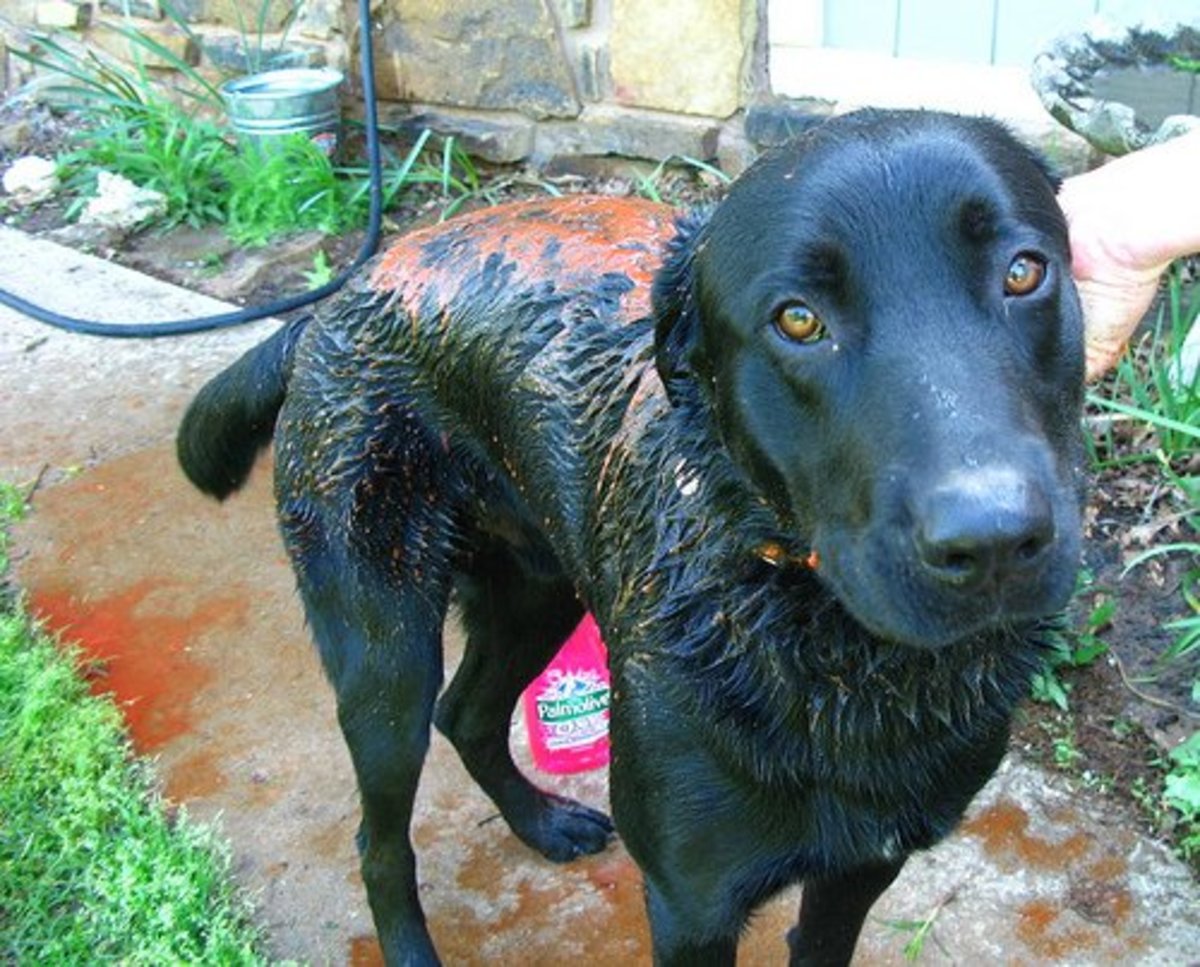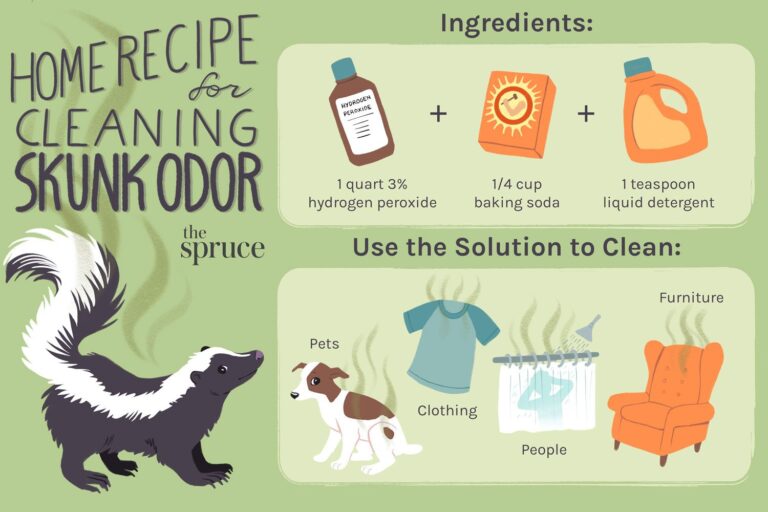To remove skunk smell from a dog’s face, mix 1 quart of 3% hydrogen peroxide, 1/4 cup of baking soda, and 1 teaspoon of liquid dish soap. Gently apply the mixture to the affected area, avoiding the eyes, and let it sit for 5 minutes before rinsing with water.
Dealing with a dog that has been sprayed by a skunk can be a challenging and smelly situation. A skunk’s musk is potent and can be difficult to eliminate, particularly from a dog’s face. However, using a specialized solution and following specific steps can effectively eradicate the unpleasant odor.
Additionally, it is crucial to handle the task promptly to prevent the odor from lingering and becoming harder to remove. Understanding how to tackle this problem can help pet owners effectively address skunk odor and restore their dog’s fresh and clean scent.

Credit: pethelpful.com
Immediate Response To Skunk Spray
Immediate Response to Skunk Spray: When a dog gets sprayed by a skunk, immediate action is crucial. Reacting promptly can help minimize the skunk odor.
Understanding the urgency of the situation: Skunk spray contains thiols, which are the primary culprit behind the pungent odor. Addressing the issue swiftly is important to prevent the strong smell from permeating the dog’s fur and skin.
Initial steps to minimize skunk odor: Upon discovering that a dog has been sprayed by a skunk, begin by removing the pet from the source of the odor and immediate isolation. Use a solution of hydrogen peroxide, baking soda, and liquid dish soap to neutralize the odor.
Safety precautions for you and your dog: When handling a pet that has been sprayed by skunk, take care to protect yourself by wearing gloves and old clothing. Avoid contact with your eyes, nose, and mouth when administering treatment to the dog. Afterward, thoroughly wash both your and the dog’s skin and clothes.
Identifying The Affected Areas
When dealing with skunk odor on your dog’s face, it’s crucial to identify the affected areas. Begin by carefully checking your dog’s face for skunk oil residue. Look for any signs of the offensive odor and focus on spots where the skunk may have sprayed. It’s essential to protect your dog’s eyes, nose, and mouth during this process to prevent any discomfort or irritation. Once you have identified the affected areas and taken necessary precautions, you can proceed with the appropriate treatment methods to effectively remove the skunk smell from your dog’s face.
Pre-cleaning Precautions
Before starting the de-skunking process, be sure to take the following precautions:
- Prepare the de-skunking solution using 1 quart of 3% hydrogen peroxide, 1/4 cup of baking soda, and 1 teaspoon of liquid dish soap.
- Ensure the workspace is well-ventilated to avoid inhaling the strong odor.
- Gather the necessary tools and materials, including rubber gloves, a sponge or washcloth, and a large bowl for mixing the solution.
Effective Home Remedies
One effective home remedy for removing skunk smell from a dog’s face is the peroxide, baking soda, and dish soap mixture. This powerful combination helps to eliminate the strong odor. Alternatively, a mixture of vinegar and water can also be used for skunk smell removal. For those seeking commercial solutions, there are skunk odor eliminators available that may be worth considering for effective results.
Monitoring Your Dog’s Reaction
Monitoring Your Dog’s Reaction
When dealing with skunk odor on your dog’s face, it’s essential to watch for signs of discomfort. Common indications of distress include excessive scratching, rubbing the face against surfaces, and redness or swelling of the affected area. If your dog exhibits these symptoms, it’s important to seek professional veterinary care promptly. Skunk spray can cause irritation and potential injury to the eyes, so immediate attention is crucial in these cases. Keeping a close eye on your dog’s behavior and physical condition will help you determine the severity of the situation and whether professional intervention is necessary.
Preventing Future Skunk Encounters
Tips for skunk-proofing your backyard: Keep garbage cans tightly sealed, use motion-activated lights, and install a skunk-proof fence to deter skunks from entering your yard.
Training your dog to avoid skunks: Teach your dog to respond to commands promptly, especially when off-leash. Use deterrents such as citronella spray to discourage your dog from approaching skunks.
Importance of wildlife awareness for pet owners: Educate yourself about skunks and other wildlife in your area. Understand their habits and habitats to minimize the risk of encounters with skunks and other potentially harmful animals.
Frequently Asked Questions For How Do You Get Skunk Smell Off A Dog’s Face
How Does A Dog Get Skunk Smell On Its Face?
When a dog gets close to a skunk, the skunk may spray its smelly odor as a defense mechanism, and the dog ends up with the smell on its face.
What Should I Do If My Dog Gets Sprayed By A Skunk?
You can use a mixture of hydrogen peroxide, baking soda, and liquid dish soap to wash the affected area. Be careful to avoid the eyes and mouth. Let the solution sit for a few minutes before rinsing it off.
Can I Use Home Remedies To Remove Skunk Smell From My Dog’s Face?
Yes, there are several home remedies to try, such as tomato juice, vinegar, or commercial skunk odor removers. Always consult a vet before using any home remedy to ensure it is safe for your pet.
Should I Take My Dog To The Vet After A Skunk Encounter?
If your dog shows signs of distress, such as excessive drooling, squinting, or rubbing its face, or if the skunk sprayed directly into its eyes, it’s best to seek veterinary care to ensure no serious damage has occurred.
Conclusion
Dealing with skunk smell on a dog’s face can be a challenge, but with the right approach, it is possible to effectively eliminate the odor. By using natural remedies or commercial products, you can help your furry friend get back to smelling fresh and clean in no time.
Remember to act quickly and be patient for the best results.



